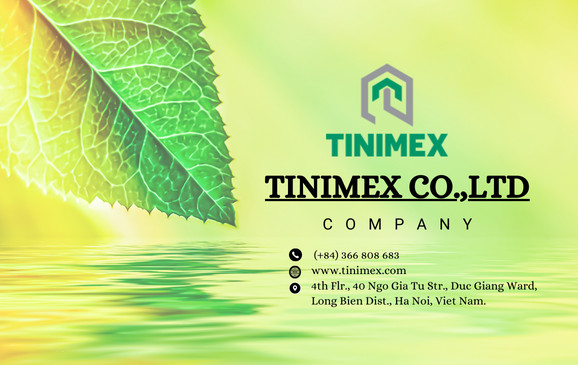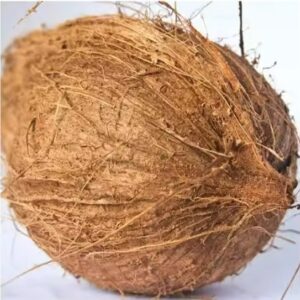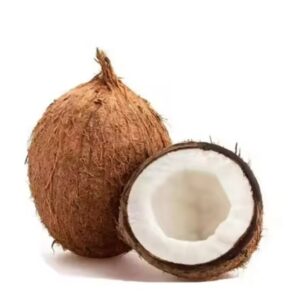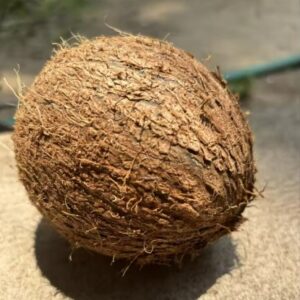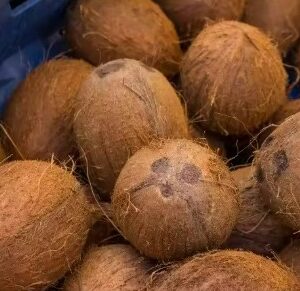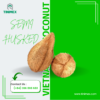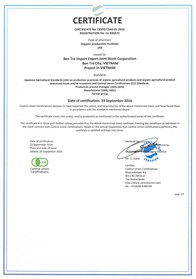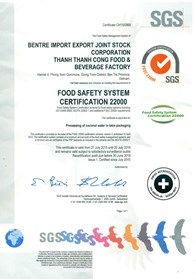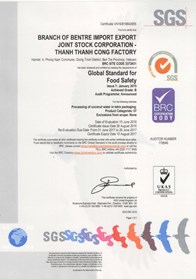FULLY HUSKED COCONUT
Liên hệ
FULLY HUSKED COCONUT
Size: 0.5-0.8kg/nuts
Age: 9 months
Packing: 25pcs/PP bag
Loading: 20’RF; 40’RF
Min order: 1 cont’ 20ft
Fully Husked Coconut
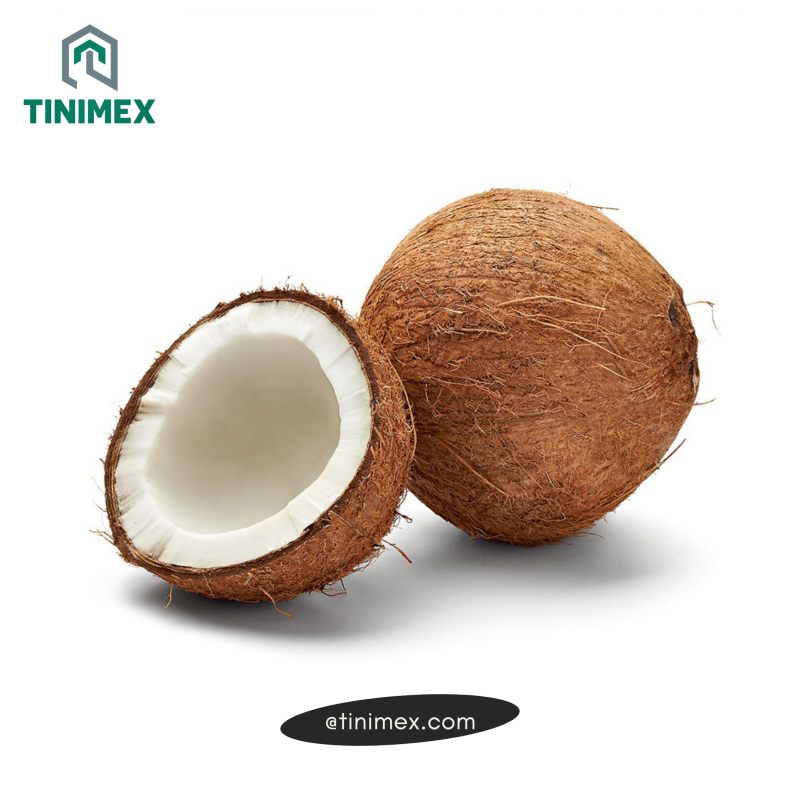
Fully husked coconut is an important product in the agricultural sector, widely used in various fields such as food, pharmaceuticals, and industry. The production process of fully husked coconut requires meticulous and careful attention at each step to ensure the final product’s quality. Below are the detailed steps in this process.
Harvesting Coconuts
The production process of fully husked coconut starts with harvesting the coconuts.
- Selecting Coconuts: Carefully select mature coconuts aged 11-12 months, with brown shells and high oil content. This is a crucial stage as the quality of the coconut directly affects the quality of the final product.
- Harvesting: Use poles or knives to pick the coconuts from the tree. Harvesting should be done in dry conditions, avoiding rain to ensure the coconuts are not damp.
Removing the Outer Shell
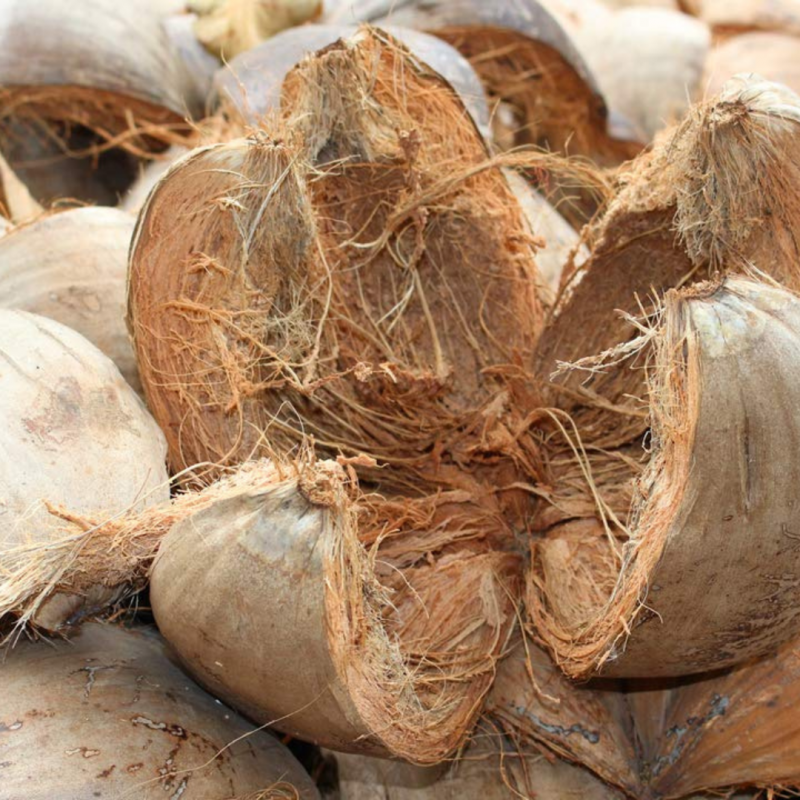
After harvesting, the next step is to remove the outer shell of the coconut.
- Peeling the Green Husk: Use a knife or peeling machine to remove the green husk and outer fiber, leaving only the hard shell of the coconut.
- Safety Measures: Ensure the use of labor protection measures to avoid accidents during the peeling process.
Washing and Cleaning
To ensure the dried coconuts are clean and safe, washing and cleaning the coconuts are very important.
- Cleaning: Wash the coconuts with clean water to remove dirt and impurities on the shell surface.
- Disinfection (optional): Soak the coconuts in a mild disinfectant solution or use hot water to kill bacteria, ensuring food safety.
Drying
Drying is a crucial step to completely remove moisture from the coconuts.
- Sun Drying: Place the coconuts in a location with direct sunlight and good ventilation. Rotate the coconuts regularly to ensure even drying. This process can take 4 to 7 days depending on weather conditions.
- Oven Drying (optional): If weather conditions are unfavorable, use an oven at about 60-70°C to dry the coconuts.
Storage
After drying, the coconuts need to be properly stored to maintain quality.
- Check for Dryness: Ensure the coconuts are completely dry, with hard shells and no internal moisture.
- Packaging: Pack the dried coconuts in airtight packaging to avoid exposure to moist air. Use plastic bags or sacks with moisture-proof linings.
- Storage: Store the dried coconuts in a dry, cool place, avoiding direct sunlight and moisture to extend their shelf life.
Quality Control
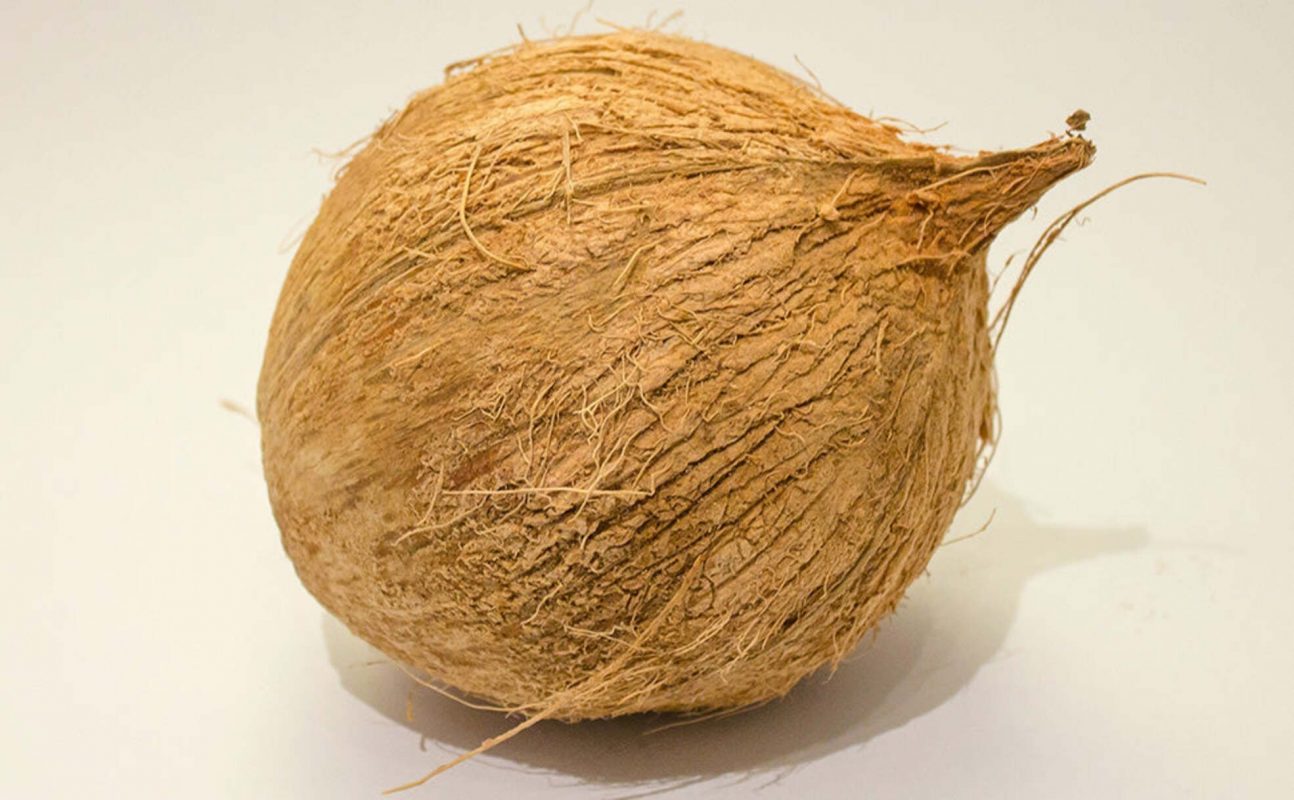
The quality control process is crucial to ensure that fully husked coconuts meet the highest standards before reaching consumers. Below are the quality standards and detailed inspection processes.
Quality Standards for Fully Husked Coconuts
Fully husked coconuts must meet the following standards:
- Clean, undamaged outer shell: The shell must be intact, without cracks, scratches, or signs of damage. The outer shell should be clean, without dirt or impurities.
- White, thick, unspoiled coconut meat inside: The coconut meat should be white, without black spots or signs of mold. The meat should meet the required thickness to ensure quality and nutritional value.
- Moisture content below the permissible level to avoid mold and bacterial growth: The moisture content must be below the permissible level (usually below 10%) to prevent mold and bacterial growth, ensuring long-term storage without spoilage.
Quality Control Procedures
-
Appearance Evaluation
- Shape Inspection: Observe and check the shape of the coconut. The coconut should have a uniform shape, not deformed or misshapen.
- Color Inspection: The outer shell should have a uniform color, without black spots or unusual colors. The shell’s shine is also an important factor, indicating thorough cleaning.
- Dryness Check: Feel and assess the dryness of the shell. It should be hard and dry, without any damp or soft spots.
-
Internal Quality Check
- Open the Coconut (if necessary): Randomly select some coconuts and open them to check the internal quality.
- Check Coconut Meat: The meat should be white, thick, without mold spots, and free from signs of spoilage like black spots or unusual odors.
- Check Coconut Water (if any): If the coconut still has water, check its clarity. The water should be clear, without sediments or unusual colors.
-
Random Inspection
- Random Sampling from the Batch: Randomly select some coconuts from the batch for detailed inspection. This ensures that the entire batch meets quality standards.
- Uniformity Check: Ensure that all coconuts in the batch have uniform quality, with no significant differences between individual coconuts.
- Recording and Reporting: Record the inspection results and prepare a detailed report on the batch’s quality. This report will be stored and used for quality control and production process improvement.
Outcome and Actions
- Accept the Batch: If the batch meets all quality standards, proceed with further steps such as packaging and shipping.
- Reject or Process: If the batch does not meet standards, proceed to reject or process the defective coconuts. Consider redoing production steps or improving the process to ensure better quality in the future.
This quality control process ensures that fully husked coconuts produced and supplied to the market always meet the highest standards, ensuring consumer satisfaction and safety.
Packaging for Export
The packaging process of dried coconuts is crucial to protect the product from environmental factors and ensure it reaches the market in optimal condition.
- Packaging Materials: Use airtight, moisture-proof packaging like thick plastic bags, vacuum bags, or sacks with moisture-proof linings. This protects the coconuts from moisture, dirt, and other contaminants during storage and transport.
- Individual Packing: Each coconut is individually packed to avoid impact and damage during handling and transportation.
- Cartons and Boxes: Coconuts are then packed into sturdy, load-bearing cartons or wooden boxes that can withstand the rigors of shipping.
- Weight Management: Each carton is kept at a manageable weight (usually around 20-25 kg) for easy handling and unloading.
- Clear Labeling: Labels on the packaging must be clear and easy to read, including information such as:
- Product Name: Fully Husked Coconut
- Origin: Vietnam
- Net Weight
- Production Date and Expiry Date
- Manufacturer Information: Name, address, contact number
- Batch Number and Barcode (if any)
Export Specifications for Fully Husked Coconuts
Exporting fully husked coconuts requires compliance with international regulations and standards to ensure product quality and food safety. Below are detailed specifications for exporting fully husked coconuts.
Quality Standards
Outer Shell
-
- The outer shell of the coconut must be clean, without cracks, scratches, or damage.
- Uniform shell color, without black spots or attached impurities.
Coconut Meat
-
- The meat inside should be white, thick, unspoiled, without mold, rot, or damage.
- The moisture content of the coconut meat should be below the permissible level (usually below 10%) to avoid mold and bacterial growth.
Weight
-
- Each coconut’s weight must meet the standards required by customers or the import market.
Packaging
Packaging Materials
-
- Use airtight, moisture-proof packaging such as thick plastic bags, vacuum bags, or sacks with moisture-proof linings.
- The packaging must be tear-resistant, sealed, and able to withstand impacts during transportation.
Packaging Specifications
-
- Each coconut should be individually packed to avoid impact and damage.
- Pack coconuts in sturdy, load-bearing cartons or wooden boxes.
- The weight of each carton should not be too heavy for easy handling and unloading (usually around 20-25 kg per carton).
Labeling
-
- Labels on the packaging must be clear and easy to read, including information such as:
- Product Name: Fully Husked Coconut.
- Origin: Vietnam.
- Net Weight.
- Production Date and Expiry Date.
- Manufacturer Information: Name, address, contact number.
- Batch Number and Barcode (if any).
- Labels on the packaging must be clear and easy to read, including information such as:
Storage and Transportation
Storage
-
- Store dried coconuts in a dry, cool place, avoiding direct sunlight and moisture.
- The ideal temperature for storing dried coconuts is from 10-25°C with humidity not exceeding 60%.
Transportation
-
- Use specialized containers or trucks with temperature and humidity control systems.
- Carefully stack the coconuts, avoiding excessive stacking to prevent damage from weight.
Export Procedures
Certification and Inspection
-
- Fully husked coconuts require quality inspection certifications such as HACCP, ISO, and food safety certifications.
- Phytosanitary Inspection: Coconuts must be inspected and certified for plant quarantine as required by the importing country.
Export Documents
-
- Sales Contract.
- Commercial Invoice.
- Packing List.
- Certificate of Origin.
- Phytosanitary Certificate.
- Bill of Lading.
Customs Regulations
-
- Comply with the customs regulations and procedures of both the exporting and importing countries.
- Prepare all necessary documents and information for smooth customs clearance.
Strict adherence to these specifications and standards not only ensures the quality of fully husked coconuts but also enhances the product’s credibility and reliability in the international market.
Location: No.40 Ngo Gia Tu Str., Duc Giang Ward, Long Bien Dist, Ha Noi City, Vietnam
Contact: +84 366 808 683
Email: info@tinimex.com
Fanpage: Tinimex
Website: Tinimex.com




Tinimex was established in 2020 specializing in manufacturing and exporting agricultural products such as:
Spices: Cinnamon, Star Anise, Cardamon, Black pepper, Ginger, Turmeric,…
Fruit with: Fresh fruit: Dragon fruit, Lime, Fresh Coconut,….
Dried fruit: Desiccate Coconut, Dried Mango, Dried Banana, Dried Jackfruit,…
Tinimex’s responsibility, in addition to the main products at the factory, we will also constantly search for new agricultural products from the growing areas or farmers, collect, produce and pack at the factory to meet the needs of customers as well as the market.
We have a head office in Hanoi and two manufacturing plants in Yen Bai Province manufacture Spices and Ben Tre Province manufacture Dried Fruit and Fresh fruit
+ Hanoi Head Office: 4th Flr., 40 Ngo Gia Tu Str., Duc Giang Ward, Long Bien Dist., Ha Noi, Viet Nam.
Our factory:
+ Yen Bai factory: Mau A Town, Văn Yen Dist., Yen Bai Province, Vietnam
+ Ben Tre Factory: Hamlet 2, Son Phu Commune, Giong Trom District, Ben Tre Province
All our Factories strictly control the system by ISO 22000:2018, HACCP, FDA.
Our factory:
+ Yen Bai factory: Mau A Town, Văn Yen Dist., Yen Bai Province, Vietnam
+ Ben Tre Factory: Hamlet 2, Son Phu Commune, Giong Trom District, Ben Tre Province
Hanoi Head Office:
4th Flr., 40 Ngo Gia Tu Str., Duc Giang Ward, Long Bien Dist., Ha Noi, Viet Nam
(+84) 366 808 683
info@tinimex.com
www.tinimex.com
All our Factories strictly control the system by ISO 22000:2018, HACCP, FDA.

Throughout the production process, every stage is tightly controlled, from sourcing raw materials to processing, with absolutely no use of harmful chemicals, preservatives, or artificial colors and flavors. Our focus is on achieving internationally recognized standards. Betrimex's products have obtained various international certifications, including ORGANIC (USDA, EU), BRC, FDA, HALAL, KOSHER, BSCI, FSSC 22000.
Our products are currently available in over 20 countries worldwide.
